Items filtered by date: October 2023
The Importance of Daily Foot Care
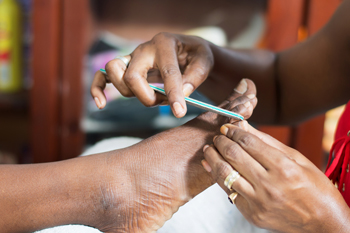
Our feet, often overlooked and underappreciated, are the unsung heroes that support your body every day. They endure a tremendous amount of stress and strain, yet it is common to neglect their care. Everyday foot care is not just a matter of comfort; it is a fundamental aspect of overall well-being. Neglecting foot health can lead to a host of problems, from painful calluses and ingrown toenails to more serious issues like fungal infections and chronic foot pain. Basic daily care involves washing and drying your feet, trimming toenails straight across, and wearing properly fitting shoes. Incorporating foot massages, stretches, and moisturizing into your routine can also enhance circulation and keep the skin supple. By taking a few minutes each day to care for your feet, you can maintain their health, prevent future problems, and ensure that they continue to support you in every step you take. There are a multitude of methods to maintain foot care. If you are interested in learning more about this, it is suggested that you visit a podiatrist who can guide you toward effective foot care techniques.
Everyday foot care is very important to prevent infection and other foot ailments. If you need your feet checked, contact Dr. John Branwell from Kearny, New Jersey. Our doctor can provide the care you need to keep you pain-free and on your feet.
Everyday Foot Care
Often, people take care of their bodies, face and hair more so than they do for their feet. But the feet are a very important aspect of our bodies, and one that we should pay more attention to. Without our feet, we would not be able to perform most daily tasks.
It is best to check your feet regularly to make sure there are no new bruises or cuts that you may not have noticed before. For dry feet, moisturizer can easily be a remedy and can be applied as often as necessary to the affected areas. Wearing shoes that fit well can also help you maintain good foot health, as well as making it easier to walk and do daily activities without the stress or pain of ill-fitting shoes, high heels, or even flip flops. Wearing clean socks with closed shoes is important to ensure that sweat and bacteria do not accumulate within the shoe. Clean socks help to prevent Athlete’s foot, fungi problems, bad odors, and can absorb sweat.
If you have any questions please feel free to contact our office located in Kearny, NJ . We offer the newest diagnostic and treatment technologies for all your foot and ankle needs.
Prevention of Athlete’s Foot
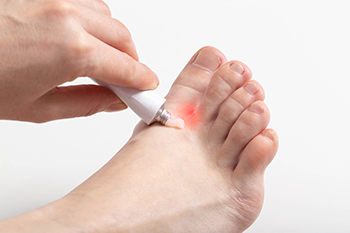
Athlete's foot, medically known as tinea pedis, is a common fungal infection that affects the skin of the feet, particularly between the toes. It's caused by various types of fungi, including trichophyton and epidermophyton, which thrive in warm, damp environments such as sweaty socks or tight shoes. Athlete's foot often starts with itching and burning sensations, followed by red, flaky, or scaly skin, and sometimes is accompanied by blisters and a foul odor. To prevent athlete's foot, it is important to maintain exceptional foot health. Wash and thoroughly dry your feet daily, ensuring the spaces between your toes are clean and dry. Changing socks frequently, especially after physical activities, can also help. Opt for breathable footwear and avoid walking barefoot in public areas like locker rooms or swimming pools. By incorporating these practices into your routine, you can combat and prevent athlete's foot, maintaining healthy and happy feet. If you have developed athlete’s foot, it is strongly suggested that you are under the care of a podiatrist who can prescribe the right course of treatment for you.
Athlete’s Foot
Athlete’s foot is often an uncomfortable condition to experience. Thankfully, podiatrists specialize in treating athlete’s foot and offer the best treatment options. If you have any questions about athlete’s foot, consult with Dr. John Branwell from Kearny, New Jersey. Our doctor will assess your condition and provide you with quality treatment.
What Is Athlete’s Foot?
Tinea pedis, more commonly known as athlete’s foot, is a non-serious and common fungal infection of the foot. Athlete’s foot is contagious and can be contracted by touching someone who has it or infected surfaces. The most common places contaminated by it are public showers, locker rooms, and swimming pools. Once contracted, it grows on feet that are left inside moist, dark, and warm shoes and socks.
Prevention
The most effective ways to prevent athlete’s foot include:
- Thoroughly washing and drying feet
- Avoid going barefoot in locker rooms and public showers
- Using shower shoes in public showers
- Wearing socks that allow the feet to breathe
- Changing socks and shoes frequently if you sweat a lot
Symptoms
Athlete’s foot initially occurs as a rash between the toes. However, if left undiagnosed, it can spread to the sides and bottom of the feet, toenails, and if touched by hand, the hands themselves. Symptoms include:
- Redness
- Burning
- Itching
- Scaly and peeling skin
Diagnosis and Treatment
Diagnosis is quick and easy. Skin samples will be taken and either viewed under a microscope or sent to a lab for testing. Sometimes, a podiatrist can diagnose it based on simply looking at it. Once confirmed, treatment options include oral and topical antifungal medications.
If you have any questions, please feel free to contact our office located in Kearny, NJ . We offer the newest diagnostic and treatment technologies for all your foot care needs.
Beginners Risk Overuse Running Injuries
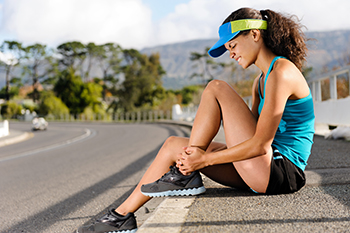
One of the most common causes of running injuries is related to overuse. But what does that mean? An overuse injury occurs when tissue is damaged due to repetitive demand over a period of time. If you are new to running, starting slow and steady is extremely important. Begin with a combination of walking and running to ease your body into the sport. Gradual progression is key to preventing overuse injuries. Additionally, it is essential to keep track of your mileage. Avoid increasing mileage by more than 10 percent per week, as pushing too hard and fast can be a recipe for overuse injury. Running more than 45 miles per week may not necessarily boost performance and could heighten your risk of injuries. When choosing your running route, opt for soft, flat surfaces, when possible. Slanted or uneven terrain can increase the strain on your muscles and joints, increasing the risk of injury. Pain is the body's way of signaling a problem. If you experience pain while running, it is wise to take a break for a few days. Variation is also key to injury prevention. Alternating between hard training days and easy recovery days helps your body recover and adapt to the demands of running. It is important to remember your footwear, and replace running shoes every 500 miles. After this distance, your shoes may no longer provide adequate shock absorption, increasing the risk of injury. For help preventing or managing overuse injuries from running, it is suggested that you make an appointment with a podiatrist.
Exercising your feet regularly with the proper foot wear is a great way to prevent injuries. If you have any concerns about your feet, contact Dr. John Branwell of Kearny, New Jersey. Our doctor will treat your foot and ankle needs.
How to Prevent Running Injuries
Many common running injuries are caused by overuse and overtraining. When the back of the kneecap starts wearing out and starts causing pain in your knee, this is commonly referred to as runner’s knee. Runner’s knee is a decrease in strength in your quadriceps and can occur if you’re not wearing properly fitted or supporting shoes. To prevent runner’s knee, focusing on hip strengthening is a good idea, as well as strengthening your quads to keep the kneecaps aligned.
What Are Some Causes of Running Injuries?
- One cause of a common running injury is called iliotibial band syndrome.
- Plantar fasciitis is also another common injury.
- Stress fractures can occur from overtraining, lack of calcium, or even your running style.
Best Ways to Prevent Running Injuries
- Wear footwear that fits properly and suits your running needs.
- Running shoes are the only protective gear that runners have to safeguard them from injury.
- Make a training schedule. Adding strengthening exercises as well as regular stretching can help keep you strong and limber and can lessen the possibility of injuries.
- Stretching keeps muscles limber; this will help you gain better flexibility.
If you have any questions please feel free to contact our office located in Kearny, NJ . We offer the newest diagnostic and treatment technologies for all your foot and ankle needs.
Arthritis Can Cause Pain in the Feet and Ankles
Recovery From Arthroscopic Ankle Surgery
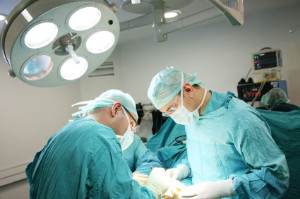
Ankle arthroscopy is a minimally invasive procedure that can greatly improve the quality of life for anyone with ankle pain and discomfort. This procedure involves making small cuts around the ankle and looking inside the incisions with an arthroscope to identify and correct issues. Recovery time can vary from person to person, but generally, patients can expect a few weeks to a couple of months for a full recovery. The first week or two may involve some discomfort and limited mobility. Most patients can resume driving within a few weeks after surgery, but it's important to consult with your podiatrist beforehand. Returning to work and sports activities may take longer, often between four to eight weeks or more, depending on the nature of your job or the intensity of your sport.
Ankle pain can have many different causes and the pain may potentially be serious. If you have ankle pain, consult with Dr. John Branwell from Kearny, New Jersey. Our doctor will assess your condition and provide you with quality foot and ankle treatment.
Ankle pain is any condition that causes pain in the ankle. Due to the fact that the ankle consists of tendons, muscles, bones, and ligaments, ankle pain can come from a number of different conditions.
Causes
The most common causes of ankle pain include:
- Types of arthritis (rheumatoid, osteoarthritis, and gout)
- Ankle sprains
- Broken ankles
- Achilles tendinitis
- Achilles tendon rupture
- Stress fractures
- Tarsal tunnel syndrome
- Plantar fasciitis
Symptoms
Symptoms of ankle injury vary based upon the condition. Pain may include general pain and discomfort, swelling, aching, redness, bruising, burning or stabbing sensations, and/or loss of sensation.
Diagnosis
Due to the wide variety of potential causes of ankle pain, podiatrists will utilize a number of different methods to properly diagnose ankle pain. This can include asking for personal and family medical histories and of any recent injuries. Further diagnosis may include sensation tests, a physical examination, and potentially x-rays or other imaging tests.
Treatment
Just as the range of causes varies widely, so do treatments. Some more common treatments are rest, ice packs, keeping pressure off the foot, orthotics and braces, medication for inflammation and pain, and surgery.
If you have any questions, please feel free to contact our office located in Kearny, NJ . We offer the newest diagnostic and treatment technologies for all your foot care needs.
Treatment for Corns on the Feet
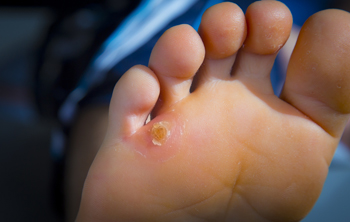
Corns on the feet can be a painful and frustrating problem. These small, hardened areas of skin can develop on the toes or bottom of the feet from friction or pressure. One cause of corns is wearing tight or improperly-fitted shoes, which can create constant friction on specific areas of the feet, leading to the formation of these painful skin growths. Also, individuals with foot deformities, such as bunions or hammertoes, may be more susceptible to developing corns. Frequent wearing of high heels, which shifts body weight toward the front of the foot and increases pressure on the toes, often results in corn development. Athletes or those engaged in activities that repeatedly stress the feet are also at a higher risk. Treatment of corns includes wearing comfortable, well-fitted shoes, using cushioned pads to alleviate pressure, and considering custom-made orthotic insoles to correct foot alignment. If a corn persists and causes discomfort, it is suggested that you make an appointment with a podiatrist. This foot doctor can safely remove a problematic corn and evaluate your feet to determine if custom orthotics may be needed in the future.
If you have any concerns regarding your feet and ankles, contact Dr. John Branwell of Kearny, New Jersey. Our doctor will treat your foot and ankle needs.
Corns: What Are They? and How Do You Get Rid of Them?
Corns can be described as areas of the skin that have thickened to the point of becoming painful or irritating. They are often layers and layers of the skin that have become dry and rough, and are normally smaller than calluses.
Ways to Prevent Corns
There are many ways to get rid of painful corns such as wearing:
- Well-fitting socks
- Comfortable shoes that are not tight around your foot
- Shoes that offer support
Treating Corns
Treatment of corns involves removing the dead skin that has built up in the specific area of the foot. Consult with Our doctor to determine the best treatment option for your case of corns.
If you have any questions please feel free to contact our office located in Kearny, NJ . We offer the newest diagnostic and treatment technologies for all your foot and ankle needs.

